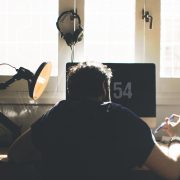Is Quarantine Turning Into a (Literal) Pain in Your Butt?
We are about 5 weeks into social distancing and doing our best to flatten the curve. Although we are all coming together as a country to do our moral duty and fight the spread of Covid-19, it doesn’t come without consequences.
More screen time and more couch time are wreaking havoc on our bodies.
Most people I speak with are making a concerted effort to be as active as they can during the day. But even the best efforts are not combatting the extra bending and sitting that is happening. It’s almost impossible to avoid it. Due to social distancing and more people working from home than ever before, our primary way of “gathering,” seeing loved ones, and communicating with co-workers is now totally digital.
Whether we like it or not, we are hunched over and leaning forward more than ever — and it’s becoming a pain in the butt, quite literally.
In our last blog post I talked about the difference between “good pain” and “bad pain.” Since then, I’ve spoken to many of you over the phone about your concerns. One of the most common questions that came across this week was about pain in your butt, and not the figurative kind!
Yes, too much sitting can cause pain in your butt, but not for the reasons you might think…
One person I spoke with thought it might be due to the hard kitchen chair he was sitting on. Makes sense, right? But when he added a cushion, and then tried moving to the recliner to do his work and online social gatherings, the pain in his butt got worse.
So he did what most of us do, and went straight to Google.
He thought that maybe he had “piriformis syndrome” and started doing the recommended stretches. The pain in his butt started to subside a little, but then spread to the back of his thigh. He thought the pain in his thigh might be due to the stretches and that it was a good thing. But after about a week of this, he woke up one morning unable to move his back! That is when he called me.
I explained that the pain in his butt was NOT due to piriformis syndrome like “Dr. Google” told him. It was actually coming from his lower back. All the extra sitting was putting pressure on his disc, which was putting pressure on his nerve, and the result was pain in his butt. Without realizing the true cause of his problem, he accidentally started doing stretches that made his problem worse. It’s very common to have a back problem and not experience any back pain. Back problems can manifest in your butt, thigh, or lower leg, and very often get confused with tight muscles that just need to be stretched. If you do the wrong stretches, you will make your problems worse and you WILL end up with back pain – often severe and seemingly out of nowhere.
Luckily, we were able to hop on a Zoom session and give him the correct stretches to do. Within a few weeks, he no longer had pain in his butt, and he knew what to do to keep it from coming back.
If quarantining is giving you a (literal) pain in your butt right now, don’t rely on Google to figure out your pain — talk to us!
We’ve been opening up extra slots on our schedules just to talk to people and help them figure out anything new or strange that might be going on.
All you have to do is fill out this quick form to request a call with one of our specialists.




